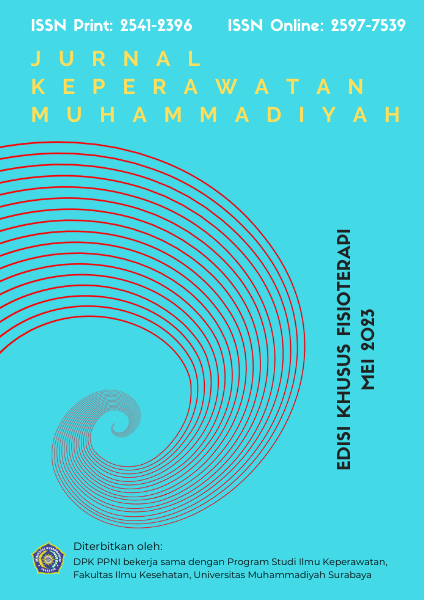Pengaruh Myofascial Release Terhadap Nyeri Spasme Otot Upper Trapezius Pada Ibu Rumah Tangga Di Rt.03 BringinBendo, Kec. Taman Sidoarjo
DOI:
https://doi.org/10.30651/jkm.v0i0.16350Keywords:
Myofascial Release, Spasme, Upper TrapeziusAbstract
Objective: The goal is to release the restrictions that create obstructions in the deeper layers of the fascia. This is achieved by stretching the elastic components of the fascia muscles, together with cross ties and changing the basic substance of the fasciaa (Shah et al., 2012) in housewives' complaints when working for a long time such as sewing, cooking in a long crouching position Musculoskeletal disorders like this If left untreated, it can cause the strength of the neck muscles to decrease so that it has an impact on decreasing productivity, increasing the risk of work-related diseases and losing time (Wahyono, Saloko, 2014).
Methods: This study used a pre-experiment with one group of pre- and post-test respondents, totaling 15 people woman. with purposive sampling technique, data collection using the NRS test. Normality test using Univariate and bivariate tests followed by data analysis using.
Results: measurement using the NRS pain meter on patient complaints of upper trapezius muscle spasm pain and interventions giving myofascial release. examination was taken during the post-test examination after that there was a change in the decrease in spasm pain of the upper trapezius muscle and the results of test the hypothesis by showing the distribution of data on the normality value of significance p< 0.05
Conclusion: Giving myofascial release has proven to be effective in reducing muscle spasms and restoring the elasticity of the fascia muscles
References
Saraswati, P.A.S., Antari, N.K.J. and Puspa Negara, A.A.G.A. (2018) ‘the Integrated Neuromuscular Inhibition Technique Is More Effective Than Contract Relax Stretching To Ultrasound Modality in Increasing Neck Range of Motion of Myofascial Syndrome in Upper Trapezius Muscle’, Majalah Ilmiah Fisioterapi Indonesia, 6(2), p. 26. doi:10.24843/mifi.2018.v06.i02.p06.
Sunyiwara, A.S., Putri, M.W. and Sabita, R. (2021) ‘Pengaruh Myofacial Release Kombinasi dengan Hold Relax terhadap Myofacial Pain Syndrome’, Jurnal Ilmiah Kesehatan, 12(2), pp. 582–587. doi:10.48144/jiks.v12i2.173.
Trisnowiyanto, B. (2012) Instrumen Pemeriksaan Fisioterapi dan Penelitian Kesehatan. Jl. Sorowajan Baru 408A Yogyakarta: Nuha Medika.
Angria P. (2020) Perbandingan pengaruh fisioterapi konservatif kombinasi myofascial release technique dengan fisioterapi konservatif kombinasi muscle energy technique pada kasus low back pain. Makasar Univ Hasanudin. 12.
Haryatno, P. and Kuntono, H.P. (2016) ‘Pengaruh Pemberian Tens Dan Myofascial Release Terhadap Penurunan Nyeri Leher Mekanik’, Interest : Jurnal Ilmu Kesehatan, 5(2), pp. 182–188. doi:10.37341/interest.v5i2.52.
Kisner, C., Colby, L. A., & Borstad, J. (2017) Therapeutic exercise: foundations and techniques. Fa Davis.
Makmuriyah and Sugijanto (2013) ‘Iontophoresis Diclofenac Lebih Efektif Dibandingkan Ultrasound Terhadap Pengurangan Nyeri Pada Myofascial’, Jurnal Fisioterapi, 13(April 2013), pp. 17–32.
Rerung, R.R. (2019) Metodologi Penelitian di berbagai bidang. Bandung-Jawa Barat: CV. MEDIA SAINS INDONESIA.
Salvishah (2020) ‘Perbedaan Pengaruh Myofascial Release Technique (MRT) Dan Kinesiotaping Trhadap Penurunan Nyeri Myofascial Pain Syndrome : Metode Narative Review Fakultas Ilmu Kesehatan Universitas ’Aisyiyah Yogyakarta’.
Samara, D. and Samara, D. (2012) ‘305-616-1-Sm’, 26(3), pp. 137–142.
Shah, S. et al. (2012) ‘Jurnal Internasional Ilmu dan Penelitian Kesehatan Rilis Myofascial’, 69–77.
Sopandi, mila amelia and Nesi (2021) ‘Indonesian Journal of Health Science Volume 1 No. 1, Juni 2021’, 1(1), pp. 16–19.
Sulistyaningsih, S. and Putri, A.R.H. (2020) ‘Myofascial Release Menurunkan Nyeri dan Meningkatkan Fungsional Leher Myofascial Pain Syndrome Otot Upper Trapezius’, Jurnal Keterapian Fisik, 5(2), 122–131. doi:10.37341/jkf.v5i2.231.
Warenski, J. (2011) ‘The Effectiveness of Myofascial Release Technique In The Treatment Of Myofascial Pain : A Literature Review’, Journal of Musculoskeletal Pain, 23, pp. 27–35.
Downloads
Published
Issue
Section
License
- Penulis tetap memegang hak atas karyanya dan memberikan hak publikasi pertama kepada jurnal ini yang secara simultan karya tersebut dilisensikan di bawah:Â Creative Commons Attribution-ShareAlike 4.0 International (CC BY-SA 4.0)













